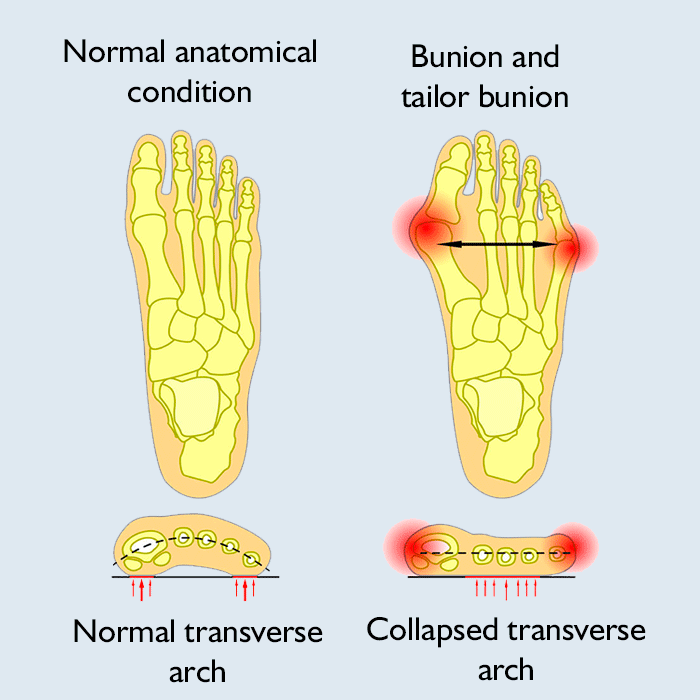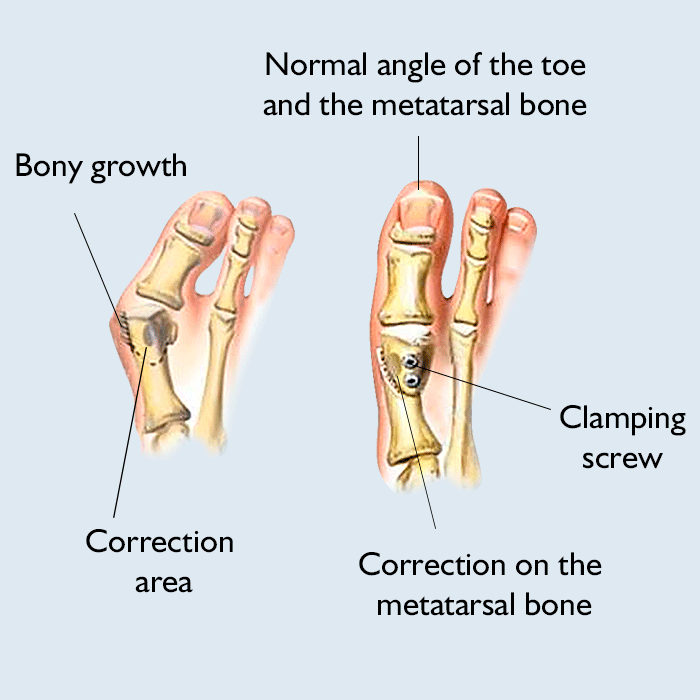Bunion removal surgery
Bunionectomy is an intervention to correct foot deformities. During the surgeries, the relation of the toe bones to each other is corrected, which helps restore the original anatomical condition of the foot.
The bunion (hallux valgus) is one of the most common deformities of the foot, which means a growth in the proximal phalanx of the big toe.
In a healthy state, the big toe is parallel to the other fingers, but in the case of a bunion, the base of the finger moves outwards, and the tip inwards, towards the other fingers and on the inside of the foot, a painful protrusion and bone growth occurs. As a result of the lesion, the spring and support function of the big toe deteriorates.
It can also occur less frequently on the outside of the foot, under the little toe, this is called tailor’s bunion.

How does the bunion form?
The main reason for the formation of the bunion is the sinking of the transverse arch, which is caused by improper weight distribution of the sole. As the foot arch flattens, the foot widens. The proximal phalanx of the toe is pulled outwards by the muscles sticking to it, so that the toe bends in the direction of the other toes, in severe cases it even curves under the second finger. The proximal phalanx thus protrudes on the inner (medial) side of the foot. Inflammation and irritation may occur on the skin, causing pain.
One of the most significant reasons for its formation is improperly chosen footwear, which can cause the transverse arch to sink and the toes to tighten. As a result of the heel being too high, the weight is concentrated on the front of the foot, changing the pressure conditions on the sole, which can be further aggravated by a tight shape that clamps the toes. This is the reason why bunions are much more common among women.
In addition, certain diseases (rheumatoid arthritis, arthritis associated with psoriasis) may be behind the development of the bunion or it can be an inherited predisposition. As we age, bunions are also more common. Bunions are often accompanied by hammer toe.
What are the symptoms of a bunion?
A characteristic symptom of a bunion is an overgrowth on the inside of the foot next to the big toe. In the inner and lateral part of the joint, the bursa can easily become inflamed under the effect of constant increased pressure (e.g. tight shoes), which is accompanied by increased pain when the inflammation flares up.
As a result of rubbing, the skin above the deformed joint can easily become inflamed, shrunk or even ulcerated. In the case of a tailor’s bunion, the characteristic symptoms are pain in the outer sole, widening of the foreleg, which may be accompanied by swelling and redness.
How can the bunion be treated?
The most important condition for treating the bunion is to restore the statics of the foot to slow down the progress of the deformity, because once the deformity develops, it can no longer be reversed.
The most important thing is to wear the right shoes, insoles or orthopaedic shoes if necessary, which leaves enough space for the toes. If possible, choose wide shoes with a round toe and heels not higher than 2-3cm. It is also worth paying attention to the exercise of the foot, during which we can strengthen the muscles holding the arch of the foot. Trainings that exercise the foot and move the toes strengthen the muscles that hold the arch.
In case of pain and inflammation, anti-inflammatory preparations can be used as symptomatic treatment. Special medical aids can also improve the condition, with a bunion toe rail at night and various silicone bunion protectors and toe separators during the day.
It is important to emphasize that a smaller deformity is always easier to treat than a more serious one. Therefore, if a small lesion occurs, consult an orthopaedic doctor as soon as possible. Restoration of the original shape of the foot is only possible surgically.
When is surgery warranted?
Bunion surgery is necessary if conservative treatment methods have not been effective and the deformity is such that it cannot be corrected in any other way, and if the complaints it cause (pain, aesthetic problem) significantly impair the patient’s quality of life.
What happens during bunion removal surgery?
During the preoperative consultation, the orthopaedist performing the surgery will provide detailed information about the necessary preoperative tests, as well as the course of the surgery and its risks.
The aim of the surgery is to correct the angle between the toe and the metatarsal bone. This goal can be achieved with several types of surgery, the chosen procedure depends on the degree of deformity and the condition of the small joints of the toes.
The operation can be performed under anaesthesia or under local (so-called spinal) anaesthesia.

The doctor makes an incision along the length of the side of the bunion and then removes the inflamed bursa that gives the “body” of the bunion and the bone outgrowth that has formed. For some surgeries, implant placement (screw, wire, or plate) may be required for restoration. After haemostasis, the doctor closes the wound with a few stitches, first the joint capsule and then unites the skin.
What are the risks of surgery?
As with any surgical procedure, bunion surgery can have risks and complications. Very rarely, inflammation and infection of the surgical site, as well as damage to the surrounding anatomical formulas: tendons, muscles, blood vessels, nerves, and adjacent bones, can occur. In case of inserted metal, an allergic reaction may occur, as well as damage and migration of the implants. In such cases, medication may be required in milder cases and repeated surgery in more severe cases.
What can I expect after the surgery?
The next day after surgery, the dressing is changed and then the patient can leave for home. In case of bunion surgery, the suture collection is due in 10-12 days.
Following bunionectomy, you should rest at home, elevate your limb for a few days. Depending on the type of surgery, it may be necessary to use special shoes that will replace normal footwear for 6-8 weeks. Complete pain relief is expected after about four weeks. The inserted metal materials can then be removed.
What can bunions cause if they remain untreated?
In case of bunions, inflammation and pain may return and increase from time to time. It is worth starting treatment as soon as possible, because due to the bad load, the metatarsophalangeal joints can be destroyed prematurely, the small joints start to wear out. Poor leg statics also affect the ankles, knees, and hip joints, and can even cause lower back pain.
What is included in the price of the bunion surgery?
The price of bunion surgery includes the cost of the surgery, as well as the cost of the hospital stay after the surgery and the follow-up examinations. The fee for the preliminary specialist consultation and the pre-operative examinations is not part of the surgical fee, please inquire about the cost of these from our Customer Service.
Convenience services
We accommodate our clients in a modern, pleasant, air-conditioned single room. Each room has a private bathroom, fridge and TV, as well as free WIFI access. We also provide our clients with individual nurse supervision, who will help your continuous recovery during your stay.
What is included in the price of our surgeries?
- costs of the surgery
- costs of anesthesia (local or general anesthesia, postoperative pain relief)
- the costs of the planned hospital stay and care
- necessary medicines and certain medical aids during the stay
- inpatient physiotherapy treatment (if necessary for rehabilitation)
- if necessary, the fee for the planned histological examination
- the price of the first follow-up examination
What additional costs might be expected?
- implants
- consultation with the anesthesiologist (must be done in Medicover)
- pre-operative examinations (if performed by us)
- in case of blood group antibody positivity, the blood matching fee
- hotel service fee for extra care days
- aids for further rehabilitation
- accompanying person staying in the hospital
- day (with one meal) 20 000 HUF
- night (full board) 60 000 HUF
- furthermore, if necessary, the cost of the 2nd follow-up examination is the fee of the specialist examination -50%, the cost of the 3rd follow-up examination is the fee of the specialist examination -30%
The course of the surgery
Before surgery
- pre-surgery specialist consultation, where the specific surgical proposal is made
- consultation with the Case Manager
- general information if necessary
- preparation of a written quotation
- booking surgery and preliminary examination appointments
- payment
-
carrying out pre-operative examinations
-
arrival for surgery
On the day of surgery
- arrival at Medicover Hospital at 6:30
- check-in at the reception on the ground floor
- occupying a room accompanied by a nurse, who provides information
- morning visit with the specialist physician and anesthesiologist
- surgery
- postoperative monitoring
- afternoon visit with the specialist physician
- constant anesthesiology specialist monitoring in the postoperative period
- discharge (with an accompanying person), final report and handing over a certificate
Surgical service process
- surgery
- hospital stay and care
- planned histology
- follow-up examination, sutur removal
